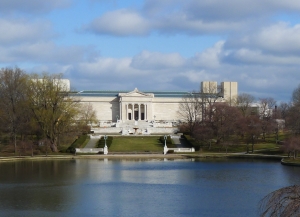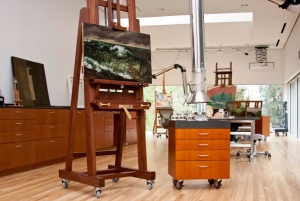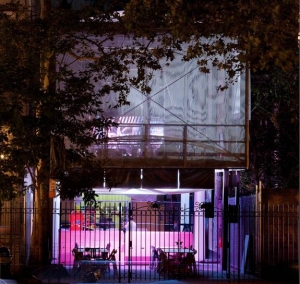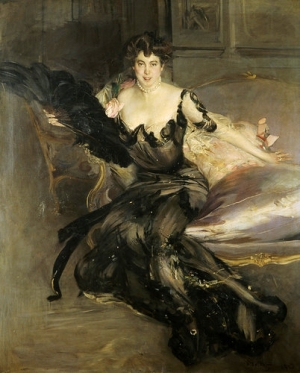|
Displaying items by tag: technology
Hundreds of paintings were discovered in the 12th century Cambodian temple complex Angkor Wat hiding in plain sight.
Though thousands of people pass through the religious monument every day, nobody had ever noticed the ancient graffiti on the faded walls. Researcher Noel Hidalgo Tan first saw the red and black pigment on the walls of the monument when he visited and decided to investigate, Smithsonian Magazine reports.

In the 1960s, the Abstract Expressionist painter Mark Rothko was commissioned by Harvard University to create a series of murals. Completed in 1962, the large panels were displayed in the University’s Holyoke Center (now the Smith Campus Center), which boasts floor-to-ceiling windows, from 1964 to 1979. Over time, the constant exposure to natural light caused the murals to fade and the once-vibrant paintings were relegated to storage, where they remained until now.
The Harvard Art Museums, which will reopen on November 16 following a major renovation, have devised a revolutionary technique to restore the murals to their original richness. The process, which was developed over several years by a team of conservators, curators, and scientists from Harvard, the Massachusetts Institute of Technology Media Lab, and the University of Basel in Switzerland, involves digitally projecting specially calibrated light to correct the murals’ devastating color loss. The works will be unveiled to the public in the exhibition “Mark Rothko’s Harvard Murals.”
After more than 17 years, police have reopened the investigation into a theft from the Ricci-Oddi Gallery in northern Italy. In February 1997, while the gallery was undergoing a renovation, thieves made off with Gustav Klimt’s “Portrait of a Woman.” The assailants, who either entered the gallery through the main entrance or removed the work through the building’s skylight, left a partial fingerprint on the painting’s frame. Investigators hope that today’s state-of-the-art technology will help identify a DNA match for the print.
The Klimt painting, which depicts a dark-haired woman, was acquired by the Ricci-Oddi Gallery in 1925. “Portrait of a Woman” is one of the most sought-after stolen paintings in Italy.
Klimt, an Austrian symbolist painter, was one of the most prominent members of the Vienna Secession movement. He is currently the subject of an exhibition at the Palazzo Reale in Milan.

The Cleveland Museum of Art announced that it has received a $10 million gift from an anonymous donor to further strengthen the institution’s mission and core principles, which focus on scholarship, artistic excellence and community engagement. Thanks to the donation, the museum has established two endowments -- one to support community engagement activities and another for interpretation of its permanent collection. Interpretation efforts will include research and curriculum development.
Recently, the Cleveland Museum of Art began to reevaluate its community engagement program and decided to transition from a traditional community arts model to a more comprehensive, multi-faceted effort. The generous gift will help the museum bring its new community engagement strategy and its related activities to fruition. The strategy will help the museum form stronger connections with local and regional communities while drawing in new audiences.
A portion of the gift was used to help fund the purchase of Deccan and Mughal paintings from a Los Angeles collection formed by Catherine Glynn Benkaim and the late Ralph Benkaim. The acquisition of the Benkaims’ collection, which includes 95 works from India’s major Islamic courts, helped diversify the Cleveland Museum’s holdings.
The donation also helped the institution complete a 3-to-1 matching grant from the National Endowment for the Humanities. The resulting fund will be used to develop and enhance text labels, audio and video clips, gallery lectures, and interactive technology. The rest of the $10 million gift will be used for a variety of projects such as public art, performances, and off-site programs.
Fred Bidwell, the Cleveland Museum of Art’s interim director, said, “This incredibly generous gift really touches upon the fundamental initiatives of the Cleveland Museum of Art. The establishment of the two endowments and the Benkaim Collection acquisition reflect the museum’s mission and help to leverage this vision to optimally benefit its diverse communities. Adhering to the highest standards of excellence in scholarship, artistic excellence and community engagement, the museum can contribute to and enhance the quality of life of Northeast Ohio citizens and beyond.”

On November 22, 2013, the Dallas Museum of Art will unveil its new Paintings Conservation Studio as part of the institution’s initiative to create a more comprehensive in-house conservation program. The studio features a digital X-ray system and a center for the study and treatment of artworks as well as research into cutting-edge conservation techniques. The studio, which is enclosed by a glass wall, will be open to visitors so that guests of the museum can observe daily conservation activity.
The opening is accompanied by an exhibition of paintings from the Dallas Museum of Art’s collection including works by Ernst Ludwig Kirchner, Childe Hassam and Julian Onderdonk; the paintings will be on view in the Conservation Gallery, which adjoins the studio. A number of works including a painting Gustave Courbet and a Renaissance portrait by Alessandro Allori will be permanently displayed in the studio.
Maxwell L. Anderson, the Museum’s Eugene McDermott Director, said, “The launch of these new conservation initiatives supports the Dallas Museum of Art’s commitment to responsible stewardship of our collection, and the advancement of conservation research and practices in the region and across the museum field. We look forward to strengthening the Dallas Museum of Art’s culture of conservation with the opening of this new facility and integrating conservation into the fabric of the Museum experience for the benefit and enjoyment of our community.”
A documentary about the Dutch painter Johannes Vermeer (1632-1675) has been acquired for distribution by Sony Pictures Classics. Tim’s Vermeer, which was directed by Teller of the illusionist duo Penn & Teller, features Tim Jenison, a Texas-based inventor who explores how Vermeer created his shockingly photo-realistic paintings a century before photography existed.
At one point during his ten-year investigation, Jenison traveled to Delft, Holland, where Vermeer worked, to meet with the British artist David Hockney, who had also questioned how Vermeer and his contemporaries created their breathtakingly realistic paintings. Using 17th century technology such as lenses and mirrors, Jenison eventually figured out the technique used by the Dutch master “supporting a theory as extraordinary as what he discovers,” Sony Pictures Classics said in a news release.
Sony Pictures Classics will release Tim’s Vermeer in 2014.

In 2010, New York’s Solomon R. Guggenheim Museum embarked on a six-year project with the luxury automobile brand BMW. The BMW Guggenheim Lab was to include three 5,000 square feet pop-up structures that would travel in consecutive cycles to one location in the U.S., one in Europe and another in Asia. The architect-designed pieces were to remain in each location for 3 months, accompanied by Guggenheim curators who would helm programs for leaders in the fields of architecture, art, science, design, technology and education in an effort to curb issues relating to urban living.
The project’s first lab opened in Manhattan’s East Village in 2011 and attracted over 54,000 visitors. The project transformed a gritty, empty lot into a handsome community center designed by the Tokyo-based architecture firm, Atelier Bow-Wow. The Lab, which was the first and last for the project, traveled to Berlin and Mumbai following its stint in NYC.
BMW officials assured the public that the company will continue to be a global partner of the Guggenheim and that they are still considering future collaborations. The lab project, which was slated to last through 2016, was supposedly reconsidered due to “strategic shifts within the company” at BMW. The exhibition Participatory City: 100 Urban Trends from the BMW Guggenheim Lab will prematurely wrap up the project. The show will be presented at the Guggenheim Museum in New York from October 11, 2013 through January 5, 2014.

Edwardian Opulence: British Art at the Dawn of the Twentieth Century is now on view at the Yale Center for British Art in New Haven, CT and explores the art created in Britain during the reign of King Edward II. The period, which is known as the Edwardian era, lasted from 1901 to 1910.
Sandwiched between the rigid Victorian era and the devastation of World War I, the Edwardian era was a time of rapid technological growth, significant artistic development, shifting political and social structures, and increased consumption among the elite. Edwardian Opulence explores how all of these changes influenced the creation, consumption, and display of British art through a range of objects.
Highlights from the exhibition include portraits by John Singer Sargent (1856-1925) and Giovanni Boldini (1842-1931), diamond-studded tiaras, vivid Autochrome color photographs, bejeweled bell pushes by Carl Fabergé (1846-1920), and an extravagantly embellished gown that belonged to the American-born Vicereine of India.
The show is comprised of 170 works from public art museums and private collections. Lenders include Queen Elizabeth II, the British Museum, the Victoria and Albert Museum, Tate Britain, the Royal Academy of Arts, the Metropolitan Museum of Art, and the Musée d’Orsay. Edwardian Opulence will be on view through June 2, 2013.

On January 21, 2013, the Cleveland Museum of Art opened Gallery One, an interactive gallery that brings together art and technology to enhance as well as personalize each museum visitor’s experience. Gallery One features the largest multi-touch screen in the United States, which displays images of over 3,500 objects from the institution’s permanent collection. Known as the Collection Wall, the touchscreen spans 40 feet and helps patrons create their own tactile tour of the museum while rotating works according to theme, time period, and technique.
Gallery One, which includes works by Pablo Picasso (1881-1973), Auguste Rodin (1840-1917), and Chuck Close (b. 1940), employs different hands-on activities to engage visitors using the power of technology. For example, one game asks viewers to recreate the poses of sculptures in the museum’s collection; the ArtLens ipad application illustrates how works of art were made, where they came from, and what inspired their creation. The ArtLens application uses image recognition software and allows visitors to scan objects and access additional multimedia content such as audio tours and educational information for up to 9 hours after their visit.
David Franklin, the Cleveland Museum’s Sarah S. and Alexander M. Cutler Director, said, “Gallery One offers an unparalleled experience for visitors of all ages. The space connects art and people, art and ideas, and people with people…we are especially proud to lead the way internationally in using technology to enhance and customize the art museum experience.”

On view through April 12, 2013 at the Cleveland Museum of Art, Picasso and the Mysteries of Life: Deconstructing La Vie is the first exhibition devoted to Pablo Picasso’s (1881-1973) complex masterpiece, which defined his well-known Blue Period. A cornerstone of the museum’s collection, La Vie (1903) is accompanied by related works on loan from Barcelona’s Museu Picasso as well as works by Francisco Goya (1746-1828), Albrecht Dürer (1471-1528), and Auguste Rodin (1840-1917) from the Cleveland Museum’s own collection.
The exhibition uses x-radiographs, infrared reflectographs, and other scientific methods to delve into the process behind La Vie. Displayed on iPads, the technological investigation illustrates Picasso’s creative process and how he altered the painting’s composition considerably before deeming the work complete.
Picasso drew preliminary sketches for La Vie in May of 1903. At the time, he was a young, unknown artist who still lived in his parents’ home in Barcelona. The first sketches depicted an artist in his studio and evolved into a more intricate scene meant to evoke thoughts about life and art and the intersection of the two. A solid analysis of La Vie has always eluded scholars due to its enigmatic subject, early history, and its relationship to Picasso’s other works from this time. However, the painting has never been examined as thoroughly and in-depth as by the Cleveland Museum of Art.
Picasso and the Mysteries of Life strives to make sense of the work by exploring the subjects of the painting. Carles Casagemas, the gaunt man featured in the work’s left foreground, was a friend of Picasso’s and a fellow artist. Casagemas committed suicide in 1901, prompting Picasso to contemplate the glorification of suicide and the bohemian lifestyle in modern art and culture. The woman standing behind Casagemas in La Vie has been identified as Germaine Pichot, his lover and a contributor to his suicide. Pichot stands as a symbol of Picasso’s coded representation of women and in a broader sense, as the fatal woman often portrayed in modern art.
A 163-page book by William H. Robinson, the Cleveland Museum’s curator of modern European art, accompanies the exhibition. The book further explores the role of La Vie in Picasso’s creative process as well as the important issues in the modernist culture of the 19th and 20th centuries that affected Picasso and his work. Robinson explores how Spanish and French literature affected Picasso’s Blue Period paintings, the impact of Rodin’s large retrospective of 1900 on the young artist, and Picasso’s ongoing struggle to fully understand the notions of fate and destiny.
Deconstructing La Vie is the inaugural exhibition in the Cleveland Museum of Art’s new Focus Gallery.
|
|
|
|
|